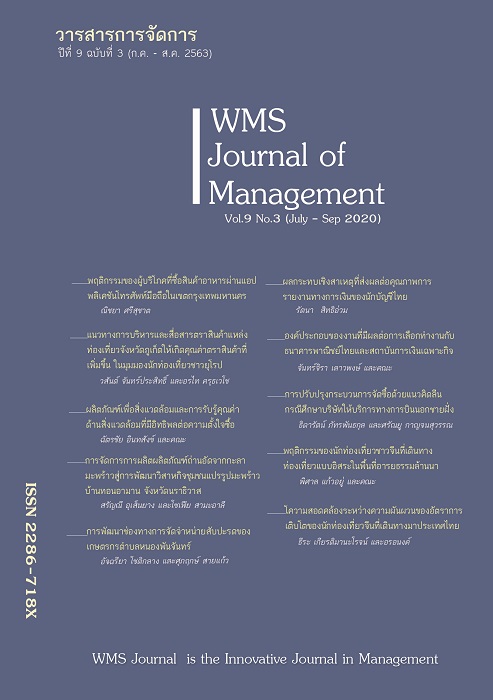Concordance between the volatility of growth rate of Chinese tourist arrivals to Thailand and Singapore
Main Article Content
Abstract
The objective of this research was to study the concordance between the volatility of the monthly growth rates of the Chinese tourists traveling to Thailand ( ) and Singapore ( ) from 2008-2017. The copula based ARMA-GARCH model was used in this research. The results showed that ARMA (0,1)-GARCH (1,1) models with Skew Normal distribution were the models suitable for the two data series. After that, the copula model was employed to analyze the concordance between the volatility of the data series: and obtained from ARMA (0,1) -GARCH (1,1) models. The results showed that the Gumbel copula was appropriate to describe the structure of concordance. The concordance value between the data series was in the form of Kendall’s tau representing the dependency, was equal to 0.45. This indicated that the volatility between the two data series was concordant in the same direction at a moderate level. That is, if the growth rate of Chinese tourists traveling to one country is low, that of another country will also be low as well. The concordance value on the upper tail was 0.54, indicating the dependent value at a moderate level between two data series on the right tail, or the data with the upper value. Therefore, if the growth rate of Chinese tourists traveling to Thailand is more volatile or extreme, the growth rate of Chinese tourists traveling to Singapore will be in a concordance manner at a moderate level or vice versa. This finding can be useful for risk management in the tourism industry related to carrying the number of Chinese tourists traveling to both countries.
Article Details
References
Aung, H.M., Nge, E.T.N., & Hichitake, Y. (2015). Destination image of Thailand and Singapore. APHEIT
Journal, 4(2),59-68.
Brechmann, E.C., & Schepsmeier, U. (2013). Modeling dependence with C- and D-Vine copulas: The R package CDVine. Journal of Statistical Software, 52(3), 1–27.
Chang, C.L., & McAleer, M. (2012). Aggregation, hetero-geneous autoregression and volatility of daily in-ternational tourist arrivals and exchange rates. The Japanese Economic Review, 63(3), 397-419.
Chiang, M.H. (2016). Tourism Exchange Between Singa-pore and China: Smooth Expansion and Bright
Prospect. In Zheng Y. & Lye F. (Eds.), Singapore-China Relations 50 Years. World Scientific Series on Singapore’s 50 Years of Nation-Building (pp. 75- 104). Singapore: World Scientific Publishing Co.
Genest, C., Ghoudi, K., & Rivest, L.P. (1995). A semipara metric estimation procedure of dependence pa rameters in Multivariate families of distributions. Biometrika, 82(3), 543–552.
Hinkle, D.E, William, W., & Stephen, G. J.(1998). Applied Statistics for the Behavior Sciences (4th ed). New York: Houghton Mifflin.
Ling, S. (2007). Self-weighted and local quasimaximum likelihood estimators for AR MA-GARCH/IGARCH models. Journal of Econo-metrics, 140(2), 849–873.
Liu J., Sriboonchitta S., Nguyen H.T., & Kreinovich V. (2014). Studying volatility and dependency of Chinese outbound tourism demand in Singapore, Malaysia, and Thailand: a vine copula approach. In Huynh VN., Kreinovich V., & Sriboonchitta S. (Eds.), Modeling dependence in econometrics. Advances in Intelligent Systems and Computing, vol.251 (pp. 259-274). Berlin: Springer.
Ministry of Tourism, Arts and Culture, Malaysia. (2019). ASEAN Tourism Package 2019-2020. Malaysia: Tourism Malasia, Ministry of Tourism, Arts and Culture, Malaysia.
Nelsen, R.B. (2006). An introduction to copulas (2nded). New York: Springer.
Patton, A.J. (2006). Modelling asymmetric exchange rate dependence. International Economic Review, 47(2), 527-556.
Phillips, P.C.B, & Perron, P. (1988). Testing for a unit root in time series regression. Biometrika, 75(2), 335-346.
Sklar, A. (1959). Fonctions de repartition a n dimen sions et leurs marges. Publ InstStatist Univ Paris, 8, 229-231.
Sriboonchitta, S., Nguyen, H.T., Wboonpongse, A., & Liu, J. (2013). Modeling volatility and dependency of ag ricultural price and production indices of Thai-land: static versus time-varying copulas. International Journal of Approximate Reasoning, 54(6), 793– 808.
Tang, J., Sriboonchitta, S., Ramos, V., & Wong, W. K. (2016). Modelling dependence between tourism demand and exchange rate using the copula-based GARCH model. Current Issues in Tourism, 19(9), 876–894.
Tangsuphoom, T. (2017). ASEAN Common Visa: impacts on Thai tourism and related laws. Ramkham-haeng Law Journal, 6(1), 117-150.
The ASEAN Secretariat. (2015). ASEAN tourism strategic plan 2016-2025. Jakarta: The ASEAN Secretari-at.
The ASEAN Secretariat. (2017). ASEAN statistical year-book 2016/2017. Jakarta: The ASEAN Secretari-at.
Trivedi, P.K., & Zimmer, D.M. (2005). Copula modeling: an introduction for practitioners. Foundations and Trends in Econometrics, 1(1), 1-111.
Untong, A. (2012). Econometrics of Tourism. Chiang Mai: Public Policy Studies Institute.
Untong, A. (2015). ASEAN long-run tourism elasticity de mand in Thailand. Applied Economics Journal, 22(2), 77-101.
Untong, A., & Kaosa-ard, M. (2015).
The competitive advantage in tourism of ASEAN in Chinese tourists’ market. Journal of Economics and Management Strategy, 2(2), 65-79.
World Travel & Tourism Council (WTTC). (2018). Travel & tourism economic impact 2018 - March 2018: South East Asia. London: World Travel & Tourism Council.
Zivot, E. & Andrew, D.W.K. (1992). Further evidence on the great crash, the oil-price shock, and the unit-root hypothesis. Journal of Business & Economics Statistics, 10(3), 251-270.


